仁爱版七年级英语下册教案Unit5Topic1SectionC新授课教案
- 格式:doc
- 大小:35.00 KB
- 文档页数:3
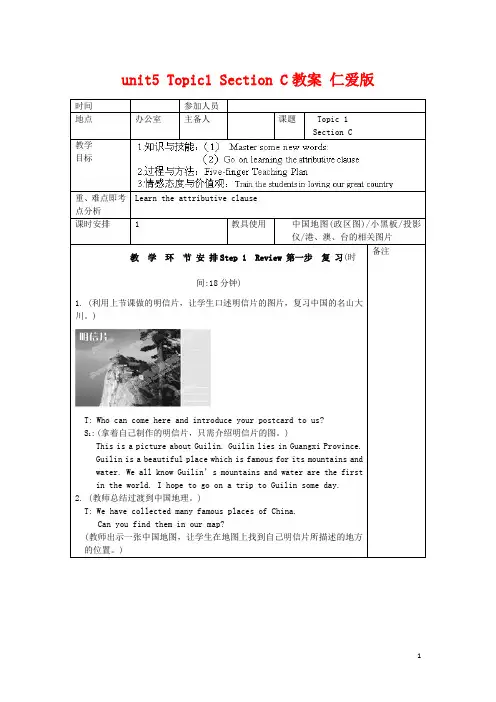
unit5 Topic1 Section C教案仁爱版Section CLearn the attributive clause教学环节安排Step 1 Review 第一步复习(时间:18分钟)1. (利用上节课做的明信片,让学生口述明信片的图片,复习中国的名山大川。
)T: Who can come here and introduce your postcard to us?S1: (拿着自己制作的明信片,只需介绍明信片的图。
)This is a picture about Guilin. Guilin lies in Guangxi Province.Guilin is a beautiful place which is famous for its mountains and water. We all know Guilin’s mountains and water are the first in the world. I hope to go on a trip to Guilin some day.2. (教师总结过渡到中国地理。
)T: We have collected many famous places of China.Can you find them in our map?(教师出示一张中国地图,让学生在地图上找到自己明信片所描述的地方的位置。
)S3: Guilin is in the south of China.S4: Mount Hong is in . It’s in the northeast of China.3. (教师总结,过渡到香港、澳门、台湾。
)(1)There are some places that have been conquered by othercountries. Can you tell me what places they are?S5: Hong Kong.S6: Macao.S7: Taiwan.Hong Kong 香港Macao 澳门Taiwan 台湾(2)(教师出示中国政区图,指出香港、澳门和台湾的地理位置。
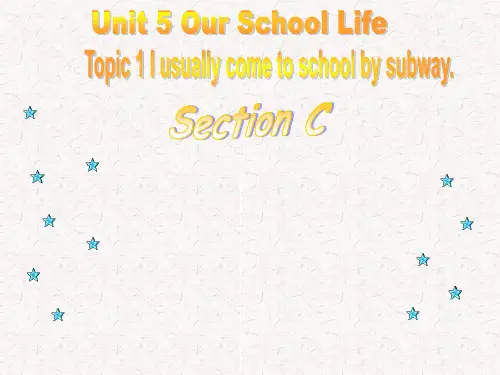

Unit5 Topic1 SectionC精品教案I. Material analysis本节课是第五单元话题一的第三课时,主要活动是1a和2。
通过介绍Jane 的一天,进一步学习用一般现在时的第三人称单数表达日常活动,巩固有关交通方式和频率的表达。
还将通过用方框中的单词和短语编对话的方式练习一般现在时的一般疑问句及其肯定和否定回答,复习日常活动和频度副词seldom和never 等。
同时学习对频率提问的句型“How often...?”和表示具体频率的副词,如once a week, twice a week, three times a week等。
语音部分主要是复习本话题所学字母及字母组合发音规律以及句子的升降调。
但是,在本课中,由于学生词汇、语法积累的不同,在将阅读输入信息转化为口头的输出时可能会出现语言组织或语法运用的障碍。
因此教师可结合图片展示、借助关键词、优生示范等活动,帮助培养学生说和复述课文的能力。
II. Teaching aims1.Knowledge aims能根据已学语音、音标及发音规则,正确朗读和拼写下列词汇:begin, at school, after, bed, basketball, swim, listen, music, library, week, once, twice在Section A和Section B的语法基础上,能熟练运用usually, often, always 等频度副词和两种交通方式的表达,能用一般现在时第三人称单数表达日常活动,能对频率进行提问与回答;在Section A已学的语音基础上,能结合图片和音标拼写单词,并能尝试结合语音发音规律拼读新单词,并了解句子的重音和升降调;能结合话题,运用“谈论日常生活、询问和回答某项活动的频度”等交际功能的用法,进行口头和笔头的信息输出,如:(1)I usually get up at ... in the morning.(2)At ... o’clock I have breakfast...(3)—How often do you come to the library?—Three times a week.2.Skill aims能听懂有关表达日常生活的叙述;能听懂简单的课堂用语,并作出反应;能根据图文就交通方式和日常活动的频度等进行交流;能在阅读训练中进行读前猜测、读中验证的活动;能根据图文理解相关话题,抓住大意和具体信息并根据要求进行学习活动;能准确写出黑体单词和词组;能写出表达交通方式和频度的简单句子。
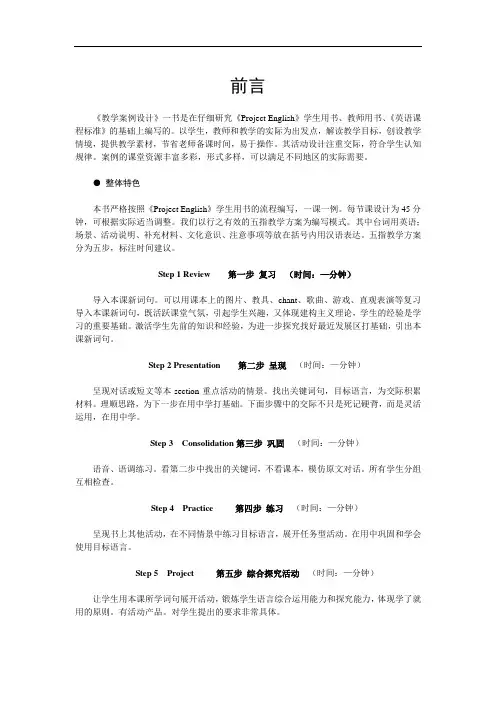
前言《教学案例设计》一书是在仔细研究《Project English》学生用书、教师用书、《英语课程标准》的基础上编写的。
以学生,教师和教学的实际为出发点,解读教学目标,创设教学情境,提供教学素材,节省老师备课时间,易于操作。
其活动设计注重交际,符合学生认知规律。
案例的课堂资源丰富多彩,形式多样,可以满足不同地区的实际需要。
●整体特色本书严格按照《Project English》学生用书的流程编写,一课一例。
每节课设计为45分钟,可根据实际适当调整。
我们以行之有效的五指教学方案为编写模式。
其中台词用英语;场景、活动说明、补充材料、文化意识、注意事项等放在括号内用汉语表达。
五指教学方案分为五步,标注时间建议。
Step 1 Review 第一步复习(时间:—分钟)导入本课新词句。
可以用课本上的图片、教具、chant、歌曲、游戏、直观表演等复习导入本课新词句,既活跃课堂气氛,引起学生兴趣,又体现建构主义理论,学生的经验是学习的重要基础。
激活学生先前的知识和经验,为进一步探究找好最近发展区打基础,引出本课新词句。
Step 2 Presentation 第二步呈现(时间:—分钟)呈现对话或短文等本section重点活动的情景。
找出关键词句,目标语言,为交际积累材料。
理顺思路,为下一步在用中学打基础。
下面步骤中的交际不只是死记硬背,而是灵活运用,在用中学。
Step 3 Consolidation第三步巩固(时间:—分钟)语音、语调练习。
看第二步中找出的关键词,不看课本,模仿原文对话。
所有学生分组互相检查。
Step 4 Practice 第四步练习(时间:—分钟)呈现书上其他活动,在不同情景中练习目标语言,展开任务型活动。
在用中巩固和学会使用目标语言。
Step 5 Project 第五步综合探究活动(时间:—分钟)让学生用本课所学词句展开活动,锻炼学生语言综合运用能力和探究能力,体现学了就用的原则。
有活动产品。
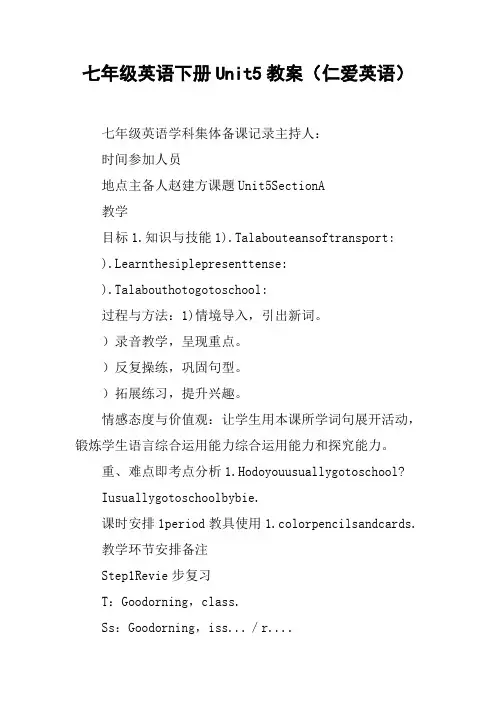
七年级英语下册Unit5教案(仁爱英语)七年级英语学科集体备课记录主持人:时间参加人员地点主备人赵建方课题Unit5SectionA教学目标1.知识与技能1).Talabouteansoftransport:).Learnthesiplepresenttense:).Talabouthotogotoschool:过程与方法:1)情境导入,引出新词。
)录音教学,呈现重点。
)反复操练,巩固句型。
)拓展练习,提升兴趣。
情感态度与价值观:让学生用本课所学词句展开活动,锻炼学生语言综合运用能力综合运用能力和探究能力。
重、难点即考点分析1.Hodoyouusuallygotoschool?Iusuallygotoschoolbybie.课时安排1period教具使用1.colorpencilsandcards.教学环节安排备注Step1Revie步复习T:Goodorning,class.Ss:Goodorning,iss.../r....T:elebactoschool,boysandgirls.I’verygladtoseeyouagain.Ss:e,too.T:hattieisit?hat’sthetie?oh,it’sseveno’cloc.It’stietogotoschool.Iusuallygotoschoolbybie/bus/subay...A:Hodoyouusuallygotoschool?B:Iusuallygotoschoolonfoot.Step2Presentation第二步呈现A:hattiedoyouaeup?B:Iaeupatsix.A:Hodoyouusuallygotoschool?B:Bybie.T:Doyounohattieanganggetsup?Let’slearn1.hat’sthetie?Isittietogetup?hoaesangangup?Hodoesanganggotoschooltoday?T:Listentothetapeandanserthequestions.aeup——6∶50——getup——early——firstday——bybieStep3consolidation第三步巩固T:Follothetapeanddra“upanddon”ithyourpencilliethis.T:Rubthecleanandreadandchecyourpronunciationsentenceb ysentence.Go!T:youareother,listentoangangandaeadialogithhi.T:orinpairs.closeyourboo,looattheblacboardandactthedialogout.Step4Practice第四步练习T:Looatthepictures.Saythephrases.S:onfoot/bybus/bycar/bybie/byplane...T:hattieisit?It’ssixo’cloc.It’stietoaeup.。
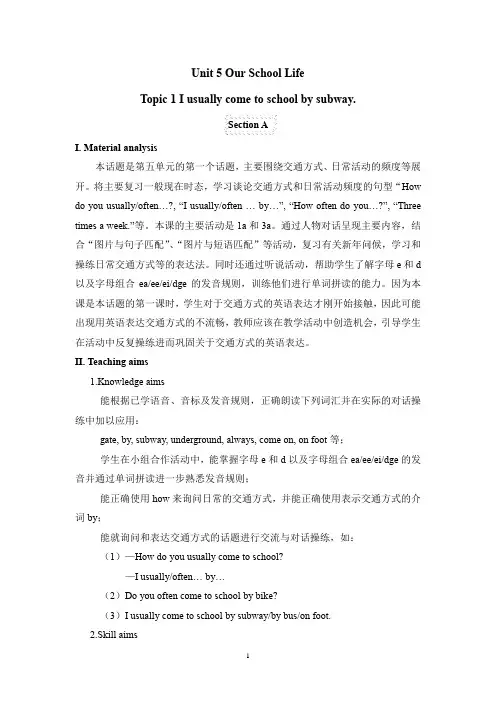
Unit 5 Our School LifeTopic 1 I usually come to school by subway.Section AI. Material analysis本话题是第五单元的第一个话题,主要围绕交通方式、日常活动的频度等展开。
将主要复习一般现在时态,学习谈论交通方式和日常活动频度的句型“How do you usually/often…?, “I usually/often … by…”, “How often do you…?”, “Three times a week.”等。
本课的主要活动是1a和3a。
通过人物对话呈现主要内容,结合“图片与句子匹配”、“图片与短语匹配”等活动,复习有关新年问候,学习和操练日常交通方式等的表达法。
同时还通过听说活动,帮助学生了解字母e和d 以及字母组合ea/ee/ei/dge的发音规则,训练他们进行单词拼读的能力。
因为本课是本话题的第一课时,学生对于交通方式的英语表达才刚开始接触,因此可能出现用英语表达交通方式的不流畅,教师应该在教学活动中创造机会,引导学生在活动中反复操练进而巩固关于交通方式的英语表达。
II. Teaching aims1.Knowledge aims能根据已学语音、音标及发音规则,正确朗读下列词汇并在实际的对话操练中加以应用:gate, by, subway, underground, always, come on, on foot等;学生在小组合作活动中,能掌握字母e和d以及字母组合ea/ee/ei/dge的发音并通过单词拼读进一步熟悉发音规则;能正确使用how来询问日常的交通方式,并能正确使用表示交通方式的介词by;能就询问和表达交通方式的话题进行交流与对话操练,如:(1)—How do you usually come to school?—I usually/often… by…(2)Do you often come to school by bike?(3)I usually come to school by subway/by bus/on foot.2.Skill aims能听懂有关表达交通方式的简单对话或叙述;能根据图文就交通方式进行交流;能理解并执行有关学习活动简单的书面指令;能正确写出黑体单词和词组;能写出表达交通方式的简单句子。
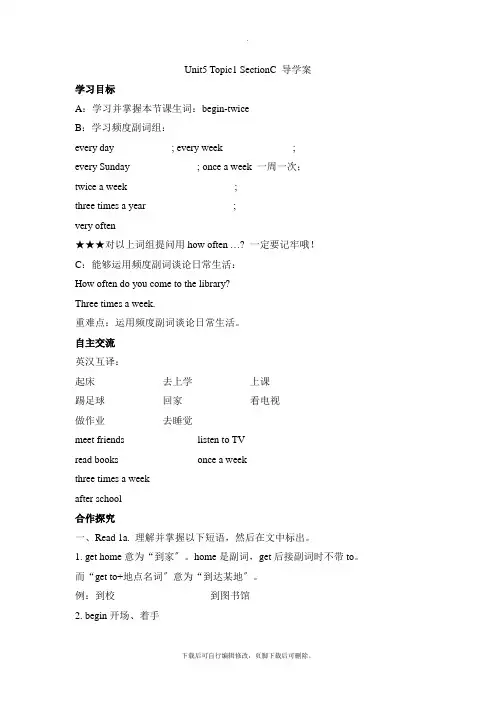
Unit5 Topic1 SectionC 导学案学习目标A:学习并掌握本节课生词:begin-twiceB:学习频度副词组:every day ___________; every week______________;every Sunday _____________; once a week 一周一次;twice a week _____________________;three times a year_________________ ;very often ________________★★★对以上词组提问用how often …? 一定要记牢哦!C:能够运用频度副词谈论日常生活:How often do you come to the library?Three times a week.重难点:运用频度副词谈论日常生活。
自主交流英汉互译:起床__________ 去上学__________ 上课__________踢足球__________ 回家__________ 看电视__________做作业__________ 去睡觉__________meet friends__________ listen to TV__________read books__________ once a week____________________ three times a week____________________after school____________________合作探究一、Read 1a. 理解并掌握以下短语,然后在文中标出。
1. get home意为“到家〞。
home是副词,get后接副词时不带to。
而“get to+地点名词〞意为“到达某地〞。
例:到校____________ 到图书馆_____________2. begin开场、着手begin doing sth.开场做某事。
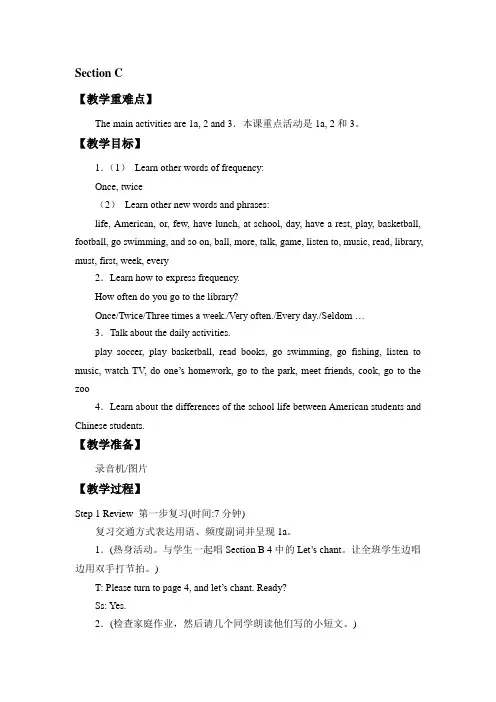
Section C【教学重难点】The main activities are 1a, 2 and 3.本课重点活动是1a, 2和3。
【教学目标】1.(1)Learn other words of frequency:Once, twice(2)Learn other new words and phrases:life, American, or, few, have lunch, at school, day, have a rest, play, basketball, football, go swimming, and so on, ball, more, talk, game, listen to, music, read, library, must, first, week, every2.Learn how to express frequency.How often do you go to the library?Once/Twice/Three times a week./Very often./Every day./Seldom …3.Talk about the daily activities.play soccer, play basketball, read books, go swimming, go fishing, listen to music, watch TV, do one’s homework, go to the park, meet friends, cook, go to the zoo4.Learn about the differences of the school life between American students and Chinese students.【教学准备】录音机/图片【教学过程】Step 1 Review 第一步复习(时间:7分钟)复习交通方式表达用语、频度副词并呈现1a。
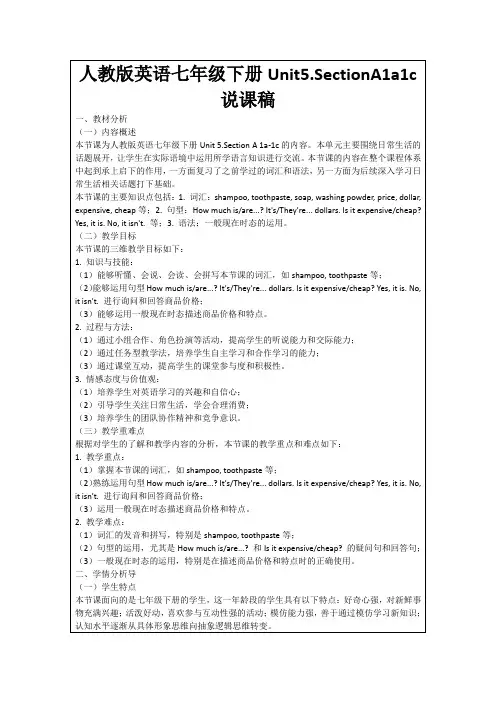
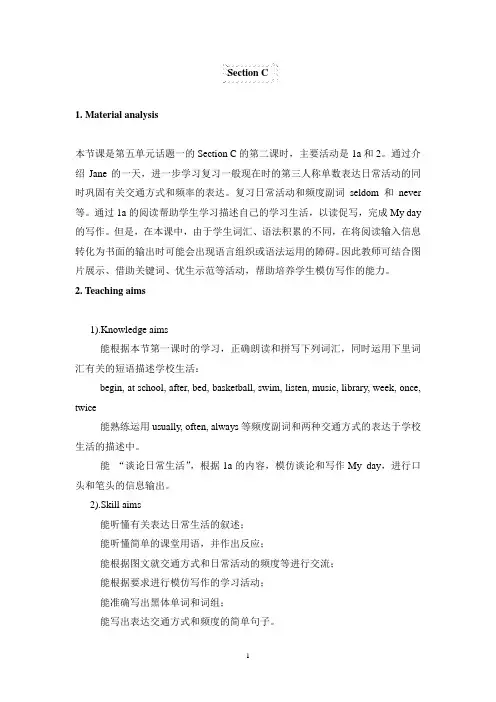
Section C1. Material analysis本节课是第五单元话题一的Section C的第二课时,主要活动是1a和2。
通过介绍Jane的一天,进一步学习复习一般现在时的第三人称单数表达日常活动的同时巩固有关交通方式和频率的表达。
复习日常活动和频度副词seldom和never 等。
通过1a的阅读帮助学生学习描述自己的学习生活,以读促写,完成My day 的写作。
但是,在本课中,由于学生词汇、语法积累的不同,在将阅读输入信息转化为书面的输出时可能会出现语言组织或语法运用的障碍。
因此教师可结合图片展示、借助关键词、优生示范等活动,帮助培养学生模仿写作的能力。
2. Teaching aims1).Knowledge aims能根据本节第一课时的学习,正确朗读和拼写下列词汇,同时运用下里词汇有关的短语描述学校生活:begin, at school, after, bed, basketball, swim, listen, music, library, week, once, twice能熟练运用usually, often, always等频度副词和两种交通方式的表达于学校生活的描述中。
能“谈论日常生活”,根据1a的内容,模仿谈论和写作My day,进行口头和笔头的信息输出。
2).Skill aims能听懂有关表达日常生活的叙述;能听懂简单的课堂用语,并作出反应;能根据图文就交通方式和日常活动的频度等进行交流;能根据要求进行模仿写作的学习活动;能准确写出黑体单词和词组;能写出表达交通方式和频度的简单句子。
3).Emotional aims在学习过程中,结合小组竞赛、同伴互助等活动,培养互相帮助、共同进步的合作精神;采用角色扮演等灵活多样的学习方式,激发学习英语的兴趣;通过了解他人的校园生活培养关心他人的意识。
3. The key points and difficult points1).能熟练运用usually, often, always等频度副词和两种交通方式的表达,能用一般现在时的第三人称单数表达日常活动、;2).培养在阅读中模仿写作的能力;3)结合话题,运用“谈论日常活动、熟练运用频度副词”等进行口头和笔头的信息输出。
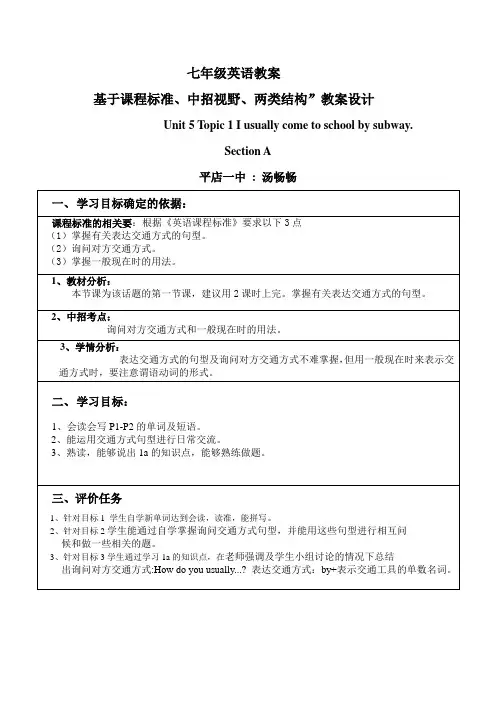
(word完整版)仁爱版七年级英语下《Unit5Topic1教案七年级英语学科集体备课记录主持人:时间参加人员刘玉峰、赵建方、程金锦、张倩地点主备人赵建方课题[]Unit 5 Section A教学目标1.知识与技能1). Talk about means of transport:2). Learn the simple present tense:3).Talk about how to go to school:2.过程与方法:1) 情境导入,引出新词。
2)录音教学,呈现重点。
3)反复操练,巩固句型。
4)拓展练习,提升兴趣。
3.情感态度与价值观:让学生用本课所学词句展开活动,锻炼学生语言能力综合运用能力和探究能力。
重、难点即考点分析1. How do you usually go to school?2. I usually go to school by bike.课时安排 1 period 教具使用 1. color pencils and cards.教学环节安排备注Step 1 Review第一步复习(时间:10分钟)1.(师生互动复习旧问候语。
)T:Good morning,class.Ss:Good morning,Miss.../Mr. ...T:Welcome back to school,boys and girls. I’m very glad to seeyou again.Ss:Me,too.2.(复习上学期的时间表达法,导入本课重点:交通工具的使用。
)T:What time is it? What’s the time?Oh,it’s seven o’clock. It’s time to go to school.I usually go to school by bike/bus/subway...((从而引出本课重点句型,并板书在黑板上。
)A:How do you usually go to school?B:I usually go to school on foot.(过渡到下一步。
Unit5Our School LifeTopic1I usually come to school by subwaySection CPart1:Teaching design()Structures: How questions; Affirmative and negative statementsTarget language:How do you get to school? I take the bus.Vocabulary: get to, how far, bicycle, subway, car, train, bus stop, train station, bus station, subway station, minute, kilometer, mile, transportation, calendarLearning strategies: Personalizing; Inferring vocabularySECTION CGoals● To learn to use How questions● Lean to talk about how to get to places,To talk about kinds of transportationProceduresWarming up by talkingHello, everyone! What’s the weather like today? It’s a sunny day with a gentlebreeze. It’s comfortable. So this morning I come to school by bike. It took menearly 50 minutes. What about you? Today, let’s talk about how you go fromone place to another. And we will talk about the time ittakes to get to places and how far it is between two places.1a.Looking and speaking.Look at the picture carefully and answer.Then please write how the students in the picture get to school in the morning in the chart.Sample answers:1. take the subway2. ride a bike3. take the bus4. take the train5. walk(on foot)6. take a boat7. take a taxi 8. go in a parent’s carAnswers:1. Bob takes the train.2. Mary takes the subway.3. John takes the bus.4. Paul walks.5. Yang Lan walks.TapescriptA: How do Bob and Mary get to school?B: Bob takes the train and Mary takes the subway.A: How does John get to school?B: He takes the bus.A: How do Paul and Yang Lan get to school?B: They walk. Look, there they are waling now!Now read the tapescript, shadow the how questions and underling the expressions.1b.Read and understand.Task1.Fast readingwhat's the best title of the passage?A.How does Jane go to school?B.Jane's morningC.Jane's dayD.Jane's homeTask2.Careful reading.(1)When do the classes begin?(2)How many classes does she have in the morning?(3)Where does she have lunch?(4)When does she play soccer with her classmates?1C.Doing pairworkLook at the pictures. Can you name each form of transportation? They are easy to you. Read the time and distance that goes with each form of transportation. Pay attention to “mile”, which is a common measure of distance in some western countries. (1 mile=1.6 kilometers).Read the example dialogue in the box.Now make your own conversations using the information in the picture with your partner.A:How do you get to school?B: I take the train.A: How long does it take you to get from home toSchool?B: It takes 35 minutes.A:How do you get to school?B:I walk.A:How long does it take you to getfrom home to school?B:It takes40minutes.A: How do you get to school?B: I take the bus.A: How long does it take you to get from home to school?B: It takes 15 minutes.OK. Stop here please. Let’s ask some pairs to say their dialogues.1d.Talking and writingWell done everyone! Now let’s play a game: Info Gap Race! This time you work in groups of three. You decide which one is A, which one is B and which one is C. Please read the instruction. You ask each other questions to learn information for your chart, and then write the answers on the chart in your book. Don’t look at others’ pages please. The first group to fill in all the blanks is the champion.C: How does Maria get to school?A: She takes the bus. How long does it take Maria to get to school?B: It takes her twenty minutes. How far is it from her home to school?C: It’s five miles.。
仁爱版英语七年级下册Unit5 topic 1 section C 教学设计一. 教材分析仁爱版英语七年级下册Unit5 topic 1 section C主要讲述了一对兄妹Anne和Frank在战争中的生活。
通过本节课的学习,学生能够掌握一般现在时的表达方式,并运用所学的词汇和句型描述日常生活中的事物。
教材以战争背景为依托,旨在培养学生对和平生活的珍惜,以及对战争的厌恶感。
此外,本节课还涉及到人物性格的描述,有助于提高学生的英语写作能力。
二. 学情分析七年级的学生已经掌握了基本的英语语法知识,能运用英语进行简单的日常交流。
但部分学生对战争背景的理解可能存在困难,因此,在教学过程中,教师需要适当引导,帮助学生理解战争对人们生活的影响。
此外,学生对人物性格描述的掌握程度不一,教师在教学中应关注学生的个体差异,提高他们的写作能力。
三. 教学目标1.知识目标:–能听懂、会说、会读本节课的主要词汇和句型。
–能运用一般现在时描述日常生活中的事物。
2.能力目标:–能用英语简单描述人物性格。
–能结合战争背景,理解课文内容。
3.情感目标:–培养学生对和平生活的珍惜,对战争的厌恶感。
–培养学生团结互助、关爱他人的品质。
四. 教学重难点•掌握一般现在时的表达方式。
•运用所学的词汇和句型描述日常生活中的事物。
•描述人物性格。
•理解战争背景,体会战争的残酷。
五. 教学方法1.情境教学法:通过设定战争背景,引导学生体验战争对人们生活的影响,激发学生的学习兴趣。
2.交际教学法:利用小组讨论、角色扮演等形式,让学生在实际语境中运用英语,提高口语表达能力。
3.任务型教学法:布置相关的写作任务,培养学生的写作能力。
六. 教学准备1.准备相关战争背景的图片、视频等资料。
2.准备本节课的主要词汇和句型的练习题。
3.准备写作任务,引导学生运用所学的词汇和句型。
七. 教学过程1.导入(5分钟)–教师展示战争背景的图片或视频,引导学生关注战争对人们生活的影响。
Topic1 SectionC优质课教案一、整体设计思路和指导依据说明该部分通过一篇Jane’s Day,以图片和时间表相辅的方式,介绍了Jane的一天。
1.按照课程理念,在阅读教学中通过给学生搭支架,从阅读前,阅读中,阅读后三个环节来进行教学,并注重培养学生复述课文和仿写输出的能力。
2.教师方面,针对初一学生,读前巧妙运用游戏导入复习,激发学生学习热情;读中利用简单的文章结构图,帮助学生梳理文章脉络,为My Day的写作做准备;读后,让学生在图片的帮助下,复述Jane的一天,最后达到以读促说,以读促写的目的。
3.在教学中根据学生以及教学的具体需要,对本课教材合理整合,以达到最佳教学效果。
具体为Part 3和Part 2为读前内容,整合为日常活动和频度副词的一个学生Pair work对话。
1a作为主体读中内容,除了书本原本的表格活动,另增设5个问题让学生进行详细阅读。
1b和1c则作为读后内容。
其中1b的复述活动,以group work开展,并由组员上台复述,为1c作文的输出提供支架。
二、教材背景分析教学内容分析:1.本教材是义务教育教科书,北京市仁爱教育研究所编著,科学普及出版社出版,英语七年级下册Unit5 Topic 1SectionC。
2.本节课是第五单元话题一的第三课时,属于话题中的阅读教学部分。
主要活动是1a和2。
通过介绍Jane的一天,进一步学习用一般现在时的第三人称单数表达日常活动,巩固有关交通方式和频率的表达。
还将通过用方框中的单词和短语编对话的方式练习一般现在时的一般疑问句及其肯定和否定回答,复习日常活动和频度副词seldom和never等。
同时学习对频率提问的句型“How often..?”和表示具体频率的副词,如once a week, twice a week, three times a week等。
3.在本课中,由于学生词汇、语法积累的不同,在将阅读输入信息转化为口头的输出时可能会出现语言组织或语法运用的障碍。
Unit 5 Topic 1 I usually come to school by subway一、单词gate, by, subway, underground, always, plane, train, ship, boat, weekday, early, bird, catch, worm, sometimes, seldom, walk, never, ride, park, watch, TV, television, soccer, movie, begin, after, bed, basketball, swim, listen, music, library, week, once, twice 二、词组come on, on foot, watch TV, at school, listen to三、句型(1)—Happy New Year!—The same to you!(2)—How do you usually come to school?—I usually come to school by subway.(3)—What time do you usually get up on weekdays?—I always get up at about six o’clock.(4)I seldom walk to school. I often come by subway.(5)Li Xiang often rides a bike to school.(6)Maira sometimes takes the subway home.(7)—What does Han Qing usually do after school?—He usually plays soccer, but he doesn’t play basketball.(8)—How often do you come to the library?—Three times a week.四、功能句1.学会询问他人的日常交通方式。